Sugar House, 99 Leman Street
1885-7, warehouse and offices for the Co-operative Wholesale Society, converted to flats 2006–7 | Part of Co-operative Wholesale Society buildings
The Co-operative Wholesale Society's London Branch Headquarters at 99 Leman Street, now partially incorporated by Sugar House
Contributed by Rebecca Preston on March 29, 2019
The Co-operative Wholesale Society's London Branch headquarters were built to designs by J. F. Goodey of 1885. At the formal opening on 2 November 1887, the CWS announced that it should ‘be their aim to make this beautiful building a common home for all the various movements having for their object the interest and advancement of the working people. They had with them their friend, the Rev. S. A. Barnett, and they hoped to work hand in hand with him and the residents of Toynbee Hall, in giving a message of hope to the people of the neighbourhood’.1
With impressive frontages on Leman Street and Hooper Square, the building wrapped around the site to meet the earlier warehouses on Rupert Street to their rear. The latter were now refurbished or rebuilt as the tea department and incorporated bacon stoves (where the green bacon, preferably Irish, was ‘smoked in wood and sawdust for about forty hours to acquire that peculiar flavour so popular in London and southern England',2 and tailoring and stationery departments. A drive-through yard for vans ran between the two phases, leading from Leman Street to Hooper Square. In addition to the demands placed on the new building by having frontages on three uneven sides and the need to incorporate the rebuilt tea department, alterations were made to the plans in consultation with the borough council for a corner of the building at the ‘back of Leman Street’, in order to avoid rights to light litigation.3 This referred, presumably, to the narrow canted south-eastern corner and the return to Goodman Street, where the building joined the entrance and stair tower of the earliest CWS warehouse. The designs for later CWS buildings on Leman Street were also modified as a result of claims and threatened injunctions over obstructions to ancient lights.
The total area of the building was now 18,000ft, with frontages of 150ft to Leman Street, 110ft to Hooper Street, and 160ft to Hooper Street and Rupert Street. The ground and first floors are of Portland stone with blue Pennant stone pilasters, the upper storeys in red brick with Portland stone dressings. The words ‘Co-operative Wholesale Society Limited’ in the recessed arch heads on the right-hand return to Hooper Street most probably also appeared in the windowless left-hand return.4 The wheatsheaf, symbolising the power of standing together, which is carved into the bay above the main entrance in Leman Street is ‘perhaps the first use of a co-operative symbol on a CWS building’.5 The accompanying motto, ‘Labor and Wait’, was the first registered trademark of the CWS, and is thought to derive from the last line of Henry Wadsworth Longfellow’s poem, Psalm of Life (published 1838); it is also said that the American spelling of Labor, used by the CWS from 1863, was in support of the anti-slavery north in the American Civil war.6 On either side are the crests and mottos of the City of London, ‘Domine Dirige Nos’ and the City of Manchester, ‘Concilio et Labore’. To the left or north of the central bay, which held the main staircase and a corridor to the tea department at the rear, lay the buyers’ offices, committee and sale rooms, and grocery and drapery departments, with a double-height assembly or lecture hall on the fifth and sixth floors.7 This was panelled in walnut, mahogany, pitch pine and sycamore, the joinery executed by W. H. Lascelles and Co.8 A richly ornamented plaster ceiling, designed by ‘veteran co-operator, Mr Newton’, was topped with a ventilated dome of stained glass. Notwithstanding the impressive front, the octagonal oriel at the Hooper Street corner was designed as ‘the principal and most striking feature’, carried from the first floor upwards to a square clock tower.9 On the ground floor this window lit the chief accountant’s office, surrounded by glazed partitions so that he could see into the clerks’ office;10 upstairs this space was incorporated into the drapery department, boot and shoe department, furnishing department and, on the fifth floor, the board or committee room and dining rooms. Memorials of ‘Co-operative Congresses and other appropriate scenes’ hung on the walnut panelling and rich flock paper of the board room and an enamel tile portrait of CWS Chairman, J. T. W. Mitchell, was set above the oval mantelpiece.11 The dining room was said to be so high that diners could see the Crystal Palace in Sydenham, while from the promenade on the roof, to which Co-operative members and other visitors were taken at special events, there ‘was almost as good a view of London and the Surrey hills as from the Monument itself’.12 Above the sixth floor, on which the kitchen and stores were located, rose the clock tower where the clock chimed the quarters and the hour ‘on a harmonious peal of five bells’. The clock faces were designed by Thwaites & Reed, makers of those for the clock at the Palace of Westminster. High above the Italianate roof, a flagstaff reached 150 feet from street level ensuring that the building could be seen as well as heard ‘for a considerable distance’. The building contractors were Martin, Wells & Co of Aldershot and London, overseen by Mr Boyce, CWS clerk of works, who was ‘visited often by the architect’.13 CWS buildings were illustrated in the CWS Annual, although, as Lynn Pearson notes, these illustrations were often somewhat fanciful.14 The erection of an additional storey indicated by district surveyors’ returns of 1896 probably represents no more than the insertion of clerestorey lighting in the roof, visible in photographs of 1933 but altered in the recent conversion.15
As a consequence of the Hooper Street fire in 1885, the CWS paid even closer attention to designing warehouses that were fireproof and providing additional checks. These included, from 1887, sprinklers in all new or adapted buildings fed from tanks on the roof and, from about 1912 until at least the 1950s, its own fire brigade based at 99 Leman Street.16 Alongside regular fire drills, annual drill competitions took place between the branches, and in the 1920s these were held at the Crystal Palace.
By 1880 the ‘Co-operative Quarter’ centred on Corporation Street in Manchester was promoting the CWS ‘in spectacular architectural fashion’ and within the decade the Society was on the way to achieving a similar presence in Whitechapel.17 The CWS initially gave its London Branch headquarters’ address as Hooper Square, Leman Street, but by about 1890, the warehouses and assembly rooms were more usually known as 99 Leman Street, an address which the present Sugar House conversion retains. This was doubtless to draw attention to the Society’s growing presence in Leman Street, since works would shortly commence on the large new tea department building opposite at 100 Leman Street, and because 99 and 100 Leman Street was deemed to be a suitably impressive pair of addresses for the CWS’s flagship buildings. The impact made by the Co-operative Wholesale locally was not solely architectural. As its warehousing expanded, many buildings were demolished, including clusters of tenements and public houses to the east and west of Leman Street, and, except at the fringes of the CWS’s growing estate locally where a handful of dark- blue and black spots remained, Booth maps and surveys of the 1880s and ’90s show an ‘improvement’ in social conditions as tenants shifted elsewhere.18 The Rev. T. Gardiner, President of Tower Hamlets Industrial Co-operative Society and sub-warden of Toynbee Hall said in 1887 that, as a former inhabitant, he remembered ‘Hooper Square a centre for squalid poverty’ and that it was now ‘the London centre of industrial distribution’.19 Leman Street was itself changing and in 1898 it was observed that ‘the whole of the SE side … below Johnson’s court is taken up by ware houses’.20
-
Opening of the New Premises and Cocoa Works, 1887, p. 42. ↩
-
Opening of the New Premises and Cocoa Works, 1887, p. 21. ↩
-
National Co-operative Archive (NCA), CWS minutes, 16 April 1886. ↩
-
‘The Co-operative Wholesale Society’s Building, Leman Street, London’, Harper’s Weekly, 9 January 1897, p. 36. ↩
-
Lynn Pearson, Architecture of the Co-operative Movement, draft Chapter 1, p. 5 and draft Chapter 2, p. 4. ↩
-
Nick Matthews, ‘The past informs the present: The co-operative movement and anti-slavery’: https://www.thenews.coop/131764/sector/community/past- informs-present-co-operative-movement-anti-slavery/. ↩
-
‘London Branch of the Co-operative Wholesale Society (Limited)’, Building News, 28 October 1887, p. 6 ↩
-
Ibid. ↩
-
Opening of the New Premises and Cocoa Works, 1887, pp. 9–11. ↩
-
Ibid., p. 14. ↩
-
Ibid., p. 212. ↩
-
Ibid., p.70: ‘Opening of New Co-operative premises in Whitechapel’, East London Advertiser, 5 November 1887, p. 7. ↩
-
Opening of the New Premises and Cocoa Works, 1887, p. 22; ‘Opening of New Co-operative premises in Whitechapel’, East London Advertiser, 5 November 1887, p. 7. ↩
-
Pearson, draft Chapter 2, p.2. ↩
-
London Metropolitan Archives (LMA), District Surveyors Returns serial no. 1896.0548. ↩
-
Opening of the New Premises and Cocoa Works, 1887, p. 71; Co- operative Wholesale Societies Limited, England and Scotland, Annual(hereafter CWS Annual), 1912, n.p.; Goad insurance plan, c.1951. ↩
-
Anthony Webster, ‘Building the Wholesale’, Business History, 54(6), 2012, pp. 890, 894. ↩
-
Charles Booth, Descriptive Map of London Poverty, 1889, section 28, MoL, 27.120/1ab; Charles Booth, Life and Labour of the People in London, 1891, Appendix II; Map Descriptive of London Poverty, 1898–9, Sheet 5, London School of Economics Archive; Walk with Inspector Reid, District 8, Aldgate, St George’s in the East, Shadwell], 9 March 1898, LSE, BOOTH/B/351. ↩
-
Opening of the New Premises and Cocoa Works, 1887, p.47. ↩
-
Walk with Inspector Reid, LSE BOOTH/B/351. ↩
Making the Sugar House - archaeological watching brief
Contributed by david2 on Oct. 30, 2018
During archaeological monitoring of substantial ground reduction on this site a culvert that predated, and was cut off by, the Co-op warehouse was briefly exposed. It was FULL of redware ceramic syrup-collecting jar fragments, with very few fragments of sugar-loaf moulds. I presume it came from a sugar house (refinery) in Leman Street in the 19th century. There were so many fragments of jars that I couldn't collect them, I simply selected out the whole vessels. I did -however- give the developers a particularly large base of a collecting vessel and they put it into the foyer of their newly refurbished building for a while, which they christened "the Sugar House". Maybe the find influenced their choice of name.
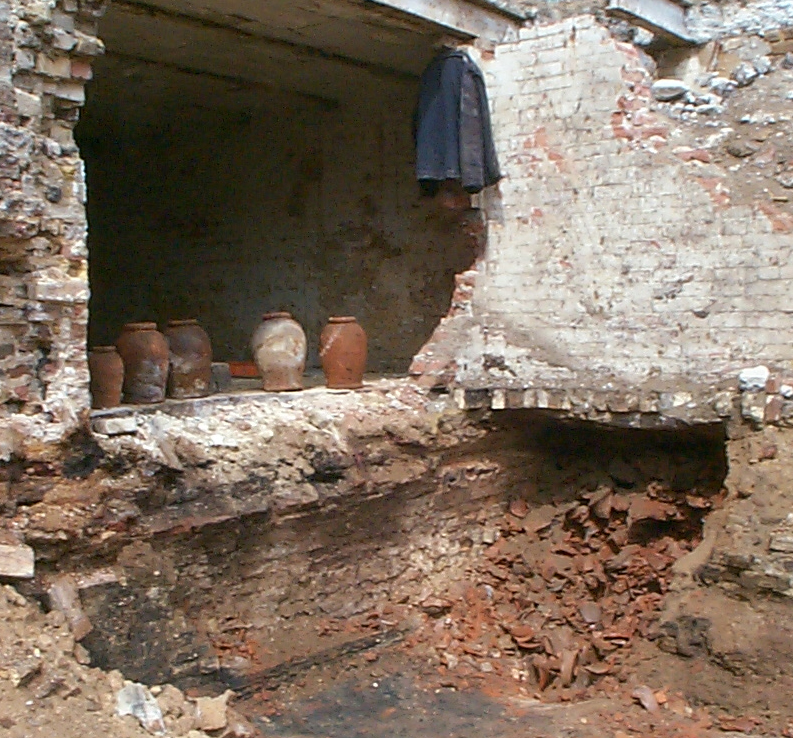 Sugar refining vessels, mainly syrup-
collecting jars, in an old culvert behind 99 Leman St.
Sugar refining vessels, mainly syrup-
collecting jars, in an old culvert behind 99 Leman St.
A picture of whole vessels is in Fig 16, page 358, on this link (Post-Medieval Archaeology, Fieldwork in 2006) https://doi.org/10.1179/174581307X236238.
The decline of the Co-operative Wholesale Society in Whitechapel and the redevelopment of the east side of Leman Street
Contributed by Rebecca Preston on March 29, 2019
By 1970 the Co-operative Wholesale Society had a number of empty premises in and around Leman Street, reflecting internal changes within the Society and national and local economic conditions. The extensive warehousing that once characterised the area declined dramatically under the influence of the closure of the London Docks and following changes to the economics of distribution.1 Although London co-operative societies had pioneered the self-service concept in 1942, the Co-op retail stores were losing their share of the market for food and consumer goods to the multiple retailers and the ensuing five decades ‘proved to be the most difficult in the history of British co-operative wholesaling and retailing’.2 In 1955, the Co-operative congress launched an inquiry into the field of wholesale and retail co- operative production and marketing and its recommendations included the reorganisation of the relationship between wholesale and retail. This meant a move away from selling to societies towards buying for them – and ‘a complete overhaul’ of the Wholesale’s warehousing policy.3 Major restructuring of the CWS took place in 1967–8, principally the creation of three divisions for food, non-food and administration, and the rationalisation of its warehousing, with some controversial closures including the historic London premises at Leman Street.4 The CWS-led ‘Operation Facelift’ of 1968 entailed the renovation of retail stores and the new CO-OP clover-leaf symbol, which later appeared on the front of 1 Prescot Street.
Meanwhile the CWS negotiated with Tower Hamlets Council for the inclusion of CWS and E&SCWS buildings within the council’s regeneration scheme, retaining some sites for the CWS banking and computer businesses with a view to selling on others for redevelopment. By 1973 the CWS had entered into a planning agreement with the Council, which specified that if CWS property at 53–73 Leman Street and 33–37 Goodmans’ Yard was used as offices, 99 Leman Street and 41–42 Goodman’s Yard would only be employed for warehousing.5 In 1974, however, 99 Leman Street was still empty and looking down-at-heel and by 1977 and probably before, had lost its stepped parapets and finials, which had survived until at least 1949.6 In 1977 the National Westminster Bank, as leaseholders from the CWS, applied to change the use of part of 53–73 Leman Street (Ekins’s 1930s’ drapery warehouse extension) and all of 75–89 Leman Street (Harris’s drapery extension of 1910) from office to light industrial use.7 A new planning agreement was issued in 1978, which released the CWS from the earlier agreement and required that the whole development be undertaken on an agreed schedule of works.8 Centre-file Ltd, a computer service company and subsidiary of the NatWest, soon occupied the former drapery extension at 75 Leman Street.9 It was a condition of Tower Hamlets’ planning consent for the conversion of No. 75 for Centre-file that Goodey’s headquarters building at No. 99 be turned into small business units managed by Tower Hamlets Council.10 Despite the bank’s objections, in the early 1980s Ian Mikardo, Labour and Co-operative MP, was allowed to use Unit 1 at 99 Leman Street, which remained in use by Tower Hamlets Centre for Small Business Ltd until the late 1980s.11 It was reported in 1980 that NatWest had donated three bells from the clock tower to the church of St Sepulchre-without- Newgate, on Holborn Viaduct, and that they were at that time resting in the Whitechapel Bell Foundry.12 St Sepulchre’s bells – famously ‘the Bells of Old Bailey’ in the nursery rhyme Oranges and Lemons – were restored in the mid-1980s and, assuming that the plan went ahead, must presumably have been incorporated those from Leman Street.13 Inside No. 99, the main staircase and its balustrade survived and the committee room retained its plastered ceiling panels, but by 2003 the mahogany mouldings and panelling had been removed.14
English Heritage stipulated that the stair tower on Hooper Street – the entrance to the first CWS warehouse of 1881 – should remain, along with Goodey’s elevations on Leman Street and Hooper Street, and the main internal staircase and balustrade. Tower Hamlets Development Committee’s suggestion in 2003 for a plaque to record the contribution to the community made by the Co- operative Wholesale Society was not carried out.15 The first phase of the Sheppard Robson redevelopment, City Quarter, was completed in 2008, and incorporates the headquarters building at 99 Leman Street – now Sugar House – and the 1910 extension by Harris, which is now called Sterling Mansions, behind which is the landscaped ‘Four Seasons’ square, designed by Fabrik landscape architects in 2012–13.16 New-build apartments, including some social housing, occupy the space where some of the earliest CWS warehousing in Whitechapel once stood.17 Of the original warehouse built in 1879–1881, only the stair tower survives, a yellow-brick column between Goodey’s red- brick headquarters building and the new flats. The new development thus preserves the awkward junction between the three phases of development, while the high-gloss white finish of the flats echoes the white-glazed bricks of the CWS warehouses that lined Goodman Street until at least the 1980s.18
-
Proof of Evidence given to Local Enquiry, 22 May 1974 by G. M. Jones for Tower Hamlets Council in support of the Greater London Council, p. 1, London School of Economics Archive, SHORE/19/100. ↩
-
John Wilson, Anthony Webster, Rachael Vorberg-Rugh, ‘The Co-operative Movement in Britain: From Crisis to “Renaissance,” 1950–2010’, Enterprise & Society, 14(2), 2013, pp .271–302, p. 279. ↩
-
Building Co-operation, pp. 247–8. ↩
-
Ibid., pp. 248–50. ↩
-
Linda Carole Johnson, ‘Planning Gain in Tower Hamlets’, unpublished PhD thesis, Brunel University, 1988, p. 252. ↩
-
Historic England Archives, Britain from Above: EAW021448; http://www.flickriver.com/photos/dmcl/tags/lemanstreet/. ↩
-
Johnson, ‘Planning Gain’, p. 252. ↩
-
Ibid. ↩
-
Estates Gazette, 8 July 1978, p. 105. ↩
-
‘Planning Gain’, pp. 252–3. ↩
-
‘Planning Gain’, p. 253; Derrick Johnstone, Developing Businesses, 1988, p. 121. ↩
-
Ross Davies, ‘Business Diary: NatWest’s hang-up’,The Times, 10 October 1980, p. 21. ↩
-
Tower Hamlets planning applications online (THP), PA/03/00585. ↩
-
THP, PA/03/00585. ↩
-
https://www.fabrikuk.com/posts/article/items/fabriks-new-plaza-at- goodmans-fields-is-now-open/. ↩
-
https://www.sheppardrobson.com/architecture/view/city-quarter. ↩
-
Photograph, 1982, London Metropolitan Archives, SC/PHL/02/0628/82/1112. ↩
Social, political and cultural activity in the Co-operative Wholesale Society's premises in and around Leman Street
Contributed by Rebecca Preston on March 29, 2019
From its early days the Co-operative Wholesale Society organised social and educational activities for its staff and hosted meetings and other events, and later on leased property to co-operative and other organisations with whom it shared interests and values. At the suggestion of Mrs Benjamin Jones, wife of the London Branch manager, the first meeting of the Women’s Co-operative Guild took place at Hooper Square on 15 April 1886, attended by over seventy women and chaired by co-operative worker Catherine Webb.1 Representatives from Toynbee Hall had been present at the opening of the new headquarters building in 1887 and from at least 1885 the settlement had put on lectures for CWS workers at Hooper Square and also held classes for co-operators at Toynbee Hall.2 A library for employees was formed at the London Branch, not long after the fire had destroyed the premises in late 1885, when board meetings were transferred temporarily to Toynbee Hall.3 When Prof Sedley Taylor started a class in economics at Toynbee Hall, CWS staff were said to have formed the nucleus of his students.4 The Wholesale considered itself a beacon in the East End, its architectural presence drawing attention to its work in the promotion of co-operation, and provided office space for kindred organisations. Thus in the late 1880s and 1890s, 99 Leman Street was the address of the Co-operative Aid Association, the Tenant Co-operators Society, and the People’s Co-operative Society. No. 99 Leman Street also hosted public lectures on co-operative and related themes. A course of twenty university extension lectures was offered on the life and duties of the citizen on Saturday afternoons in 1893, held after the working week had finished at 4 o’clock on Saturdays in the Conference Hall. These were free to co-operators and 5s (or 2s 6d for the half course of ten) to the general public.5 In 1901, the Countess of Warwick presided at a conference at London Branch headquarters on London School Board Evening Continuation Classes.6
During the Co-operative Wholesale ‘tea girls’ strike’ over piecework at the tea department in 1904, Canon Barnett offered the women a room at Toynbee Hall while he opened negotiations between the CWS and the Women’s Trade Union League.7 In the 1930s, Toynbee Hall organised for parties of undergraduates and public school children to be taken around CWS premises locally.8 By the 1920s, in addition to the various departments and bank, 99 Leman Street was also home to the CWS Financial Propaganda Department, CWS Social Club, the Co- operative Press Agency and the Russo-British Co-operative Information Bureau.9 London Branch employees’ activities on site included a fine art club, with ‘notable exhibits of painting and sculpture from Leman Street’ being shown in the 1930s at the East End Academy in the Whitechapel Art Gallery.10 An Ethiopian Exhibition organised by Sylvia Pankhurst on behalf of the Princess Tsahai Memorial Hospital Fund, of which Pankhurst was the honorary secretary, was displayed during 1948 in the Boot and Shoe Showrooms at 99 Leman Street. Ancient Ethiopian traditional dress, embroidery, leather- work and illuminated books appeared alongside examples of modern textiles. This formed part of a project to form closer relations with ‘the brave Ethiopian people whose struggle against the aggression of Mussolini aroused sympathy and interest in this country’. A film, ‘This is Ethiopia’, was shown in the CWS film theatre at the Tea Office across the road in Prescot Street.11
-
Catherine Webb, The Woman with the Basket: The History of the Women’s Co-operative Guild, 1883–1927, 1927, p. 28. ↩
-
‘Opening of new Co-operative Premises in Whitechapel’, East London Advertiser, 5 November 1887, p. 7; Asa Briggs and Anne Macartney, Toynbee Hall: The First Hundred Years, 1984, p. 45. ↩
-
National Co-operative Archive (NCA), CWS Minutes, 29 February 1886. ↩
-
London Branch of the CWS, 1933, p. 30. ↩
-
Co-operative Union Southern Section, A Course of Twenty University Extension Lectures…, 1893, [p. 1]. ↩
-
‘Knowledge or Ignorance’, Sunday Times, 24 March 1901, p. 8. ↩
-
‘Co-operative Wholesale Girls’ Strike’, London Daily News, 12 October 1904, p. 8. ↩
-
Correspondence with the Co-operative Wholesale Society, Leman Street, re visit by Toynbee Hall students, November 1937, London Metropolitan Archives (LMA), A/TOY/015/002/047–048. ↩
-
Daily Herald, 1 January 1921, p. 6; CWS Annual, 1918, p. 289; People’s Yearbook, 1921, p. 377; The Producer, July 1925, p. 266. ↩
-
New History of the C.W.S., 1938, p. 506. ↩
-
‘Ethiopian Exhibition’, The British Journal of Nursing, July 1948, p. 85. ↩
The Co-operative Wholesale Society around Leman Street and its beginnings in London
Contributed by Rebecca Preston on March 29, 2019
The Co-operative Wholesale Society (CWS) opened its first warehouse in Whitechapel in 1881, on a plot on the north side of the present Hooper Street, just to the east of Leman Street. Very quickly, as CWS business expanded, the organisation bought up and built on neighbouring plots and by the 1930s this corner of Whitechapel was home to a series of impressive warehouses, offices, factories, showrooms and a bank, which flanked Leman Street and surrounding roads. Designed by CWS architects and engineers, many of the buildings in what became a Co-operative Wholesale colony have now gone and what remains has mostly been converted to apartments. Of the original warehouse built in 1879–1881, only the stair tower survives, a yellow-brick column to the rear of the CWS London Branch headquarters building at 99 Leman Street, which opened in 1887. That and some of its CWS successors still dominate the vicinity, not without a degree of architectural spectacle.
The Co-operative Wholesale Society – now The Co-operative Group – was founded in Manchester in 1863, to supply basic foodstuffs and daily necessities wholesale to Co-operative retailers. The wholesale society was a federal organisation, owned by the retail societies it traded with, and sought to integrate production and distribution in order to lower costs. As is well known, the co-operative principle of mutual benefit was established in 1844 by the Rochdale Equitable Pioneers’ Society, many of whose members had backgrounds in earlier co-operative, communitarian and socialist ventures.1 From around the mid-century, efforts were made to set up a central wholesale agency, culminating in what became the CWS.2 It began as the North of England Co-operative & Wholesale Industrial Society Ltd and expanded rapidly to serve the growing number of retail societies in England and Wales. When it became impossible to serve these from Manchester alone, subsidiary wholesale branches were set up in Newcastle-upon-Tyne in 1871 and in London in 1874. 3 London was considered difficult terrain, a ‘co-operative desert’ in need of irrigation and the story of the struggle to gain a foothold in the capital was characterised in 1913 as ‘the attack on London’.4
The CWS aimed to procure unadulterated goods at low prices, by ‘eliminating the middle-man and his profits’ rather than economising on labour.5 Beginning with butter, which accounted for a third of sales in the first decade, the CWS built a network of buyers, suppliers and, crucially, depots, which facilitated bulk purchasing and centralised processing in order to secure the best prices and quality.6 The co-operative principle of avoiding middlemen also underlay the Society’s policy in London of, wherever possible, purchasing the freeholds of its premises, ‘for co-operators, being prudent men, have a righteous horror of the short leasehold system’.7 Thus the CWS and a little later the English & Scottish Joint CWS (E&SCWS) became significant landowners in Whitechapel.
The first London Branch premises opened in 1874 at 118 Minories, a warehouse backing onto America Square on the eastern edge of the City of London. This was convenient for the docks and for markets, in particular Mincing Lane in the City, which was the centre of the international tea trade from the 1830s. The London Public Tea Auction, held in the London Commercial Sale Rooms at Mincing Lane, was established in 1834 after the dismantling of the East India Company monopoly.8 Tea fit with the temperance beliefs of many early co- operators and from the foundation of the Wholesale Society formed an important CWS commodity; it remained so as consumption of tea increased nationally, only levelling off in the 1940s.9 Within a few years of opening in London the business had outgrown the space available and the CWS began to look for larger premises. ‘Great difficulty was found in selecting a freehold site which would be at once convenient for the various markets and the railways’ but by the end of the 1870s a site in Whitechapel had been decided upon and in 1881 new London Branch premises were opened near Leman Street, less than half a mile east of the Minories.10 As the Society consistently pointed out to its members, Leman Street was both the highway to the docks and ‘conveniently adjacent’ to bonded tea warehouses.11 The premises were also keenly positioned within the railway network and bordered on the site of the future London, Tilbury & Southend Railway (Commercial Road) goods depot and its vast warehouses, which, when it opened in 1886, provided a link to the East & West India Dock Company’s new dock at Tilbury.12
-
Lynn Pearson, Architecture of the Co-operative Movement, draft Chapter 1: Laying the Foundations: Retail Societies, 1844–1890, 2018, p. 2. We are grateful to Lynn Pearson for help with this account. ↩
-
Pearson, Architecture of the Co-operative Movement, draft Chapter 2: Pioneering Production: CWS Depots and Factories, 1863–1897, p. 2. ↩
-
Anthony Webster, ‘Building the Wholesale: The Development of the English CWS and British Co-operative Business 1863–90’, Business History, 54(6), 2012, pp. 883–904, p. 894. ↩
-
Co-operative Wholesale Society Limited, London Branch, Opening of the New Premises and Cocoa Works, 1887, p.54; Percy Redfern, The Story of the C.W.S. The Jubilee History of the Co-operative Wholesale Society Limited, 1913, p.83; Webster, ‘Building the Wholesale’, p. 885. ↩
-
A. D. Harrison, ‘Review of The Story of the C.W.S. by Percy Redfern’, Charity Organisation Review, New Series, Vol. 35, No. 205 (January 1914), pp. 46–8, p. 46. ↩
-
Pearson, draft Chapter 2, p.1. ↩
-
Opening of the New Premises and Cocoa Works, p. 70. ↩
-
Markman Ellis, Richard Coulton and Matthew Mauger, Empire of Tea: The Asian Leaf that Conquered the World, 2015, p.249. ↩
-
Bishnupriya Gupta, ‘The History of the International Tea Market, 1850–1945’, EH.Net Encyclopedia, ed. Robert Whaples, 16 March 2008: https://eh.net/encyclopedia/the-history-of-the-international-tea- market-1850-1945/. ↩
-
Opening of the New Premises and Cocoa Works, 1887, p. 9 ↩
-
‘CWS: Tea Growers, Blenders, and Packers II’, The Wheatsheaf, February 1908, p. 120. ↩
-
Tim Smith,‘Commercial Road Goods Depot, Whitechapel’, Greater London Industrial Archaeology Society, 1979,re-typed with annotations, January 2000: http://www.glias.org.uk/journals/2-a.html. ↩
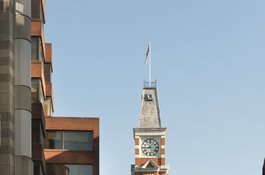
View to Sugar House from Prescot Street in 2019
Contributed by Derek Kendall
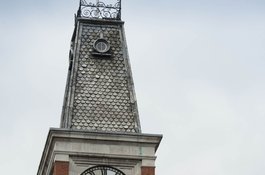
Sugar House, clock tower from the south in 2017
Contributed by Derek Kendall
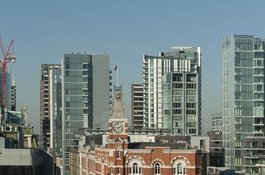
Sugar House from the south looking across the Docklands Light Railway in 2019
Contributed by Derek Kendall
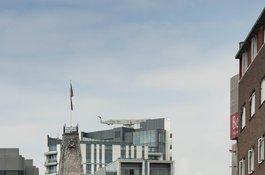
Sugar House from the south in 2017
Contributed by Derek Kendall
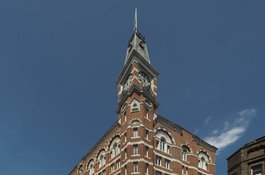
Sugar House from the southwest in 2017
Contributed by Derek Kendall
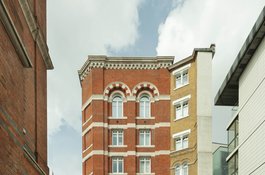
Sugar House, Hooper Street elevation in 2019 showing the remnant of the earlier CWS building at the corner
Contributed by Derek Kendall
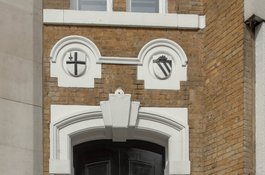
The doorway of the CWS building of 1881 on Hooper Street
Contributed by Derek Kendall
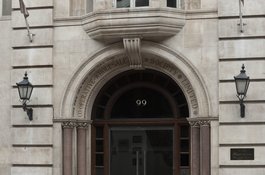
Sugar House, entrance detail in 2017
Contributed by Derek Kendall
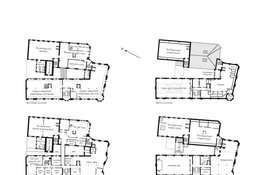
CWS Headquarters (now Sugar House), floor plans as built in 1887 (drawing by Helen Jones)
Contributed by Survey of London
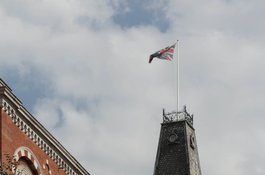
Sugar House, clock tower from the northwest in 2017
Contributed by Derek Kendall
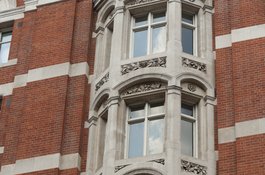
Sugar House, bay window detail in 2017
Contributed by Derek Kendall
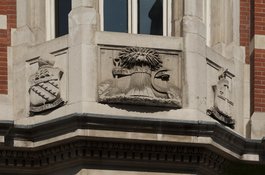
Sugar House, carved panels at base of bay window, 2017
Contributed by Derek Kendall
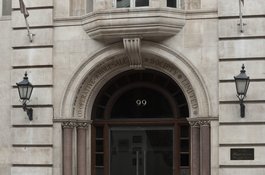
Sugar House, entrance detail in 2017
Contributed by Derek Kendall
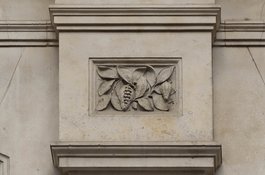
Sugar House, ornament detail, 2017
Contributed by Derek Kendall

Sugar House, ornament detail, 2017
Contributed by Derek Kendall

The Co-operative Wholesale Society estate in 1968
Contributed by Helen Jones